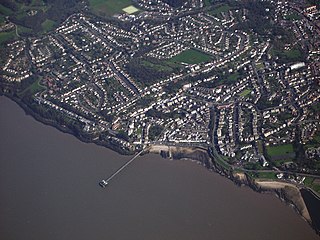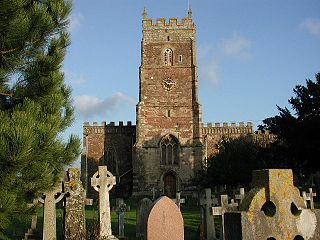
Weston-super-Mare, also known as just Weston, is a seaside town in Somerset, England, part of the unitary authority of North Somerset. It lies by the Bristol Channel 18 miles (29 km) south west of Bristol between Worlebury Hill and Bleadon Hill. It includes the suburbs of Oldmixon, West Wick and Worle. Its population at the 2011 census was 76,143. Since 1983, Weston has been twinned with Hildesheim, Germany.

Clevedon is an English town and civil parish in the unitary authority of North Somerset, which covers part of the ceremonial county of Somerset. It recorded a population of 21,281 in the United Kingdom Census 2011. It lies among a group of small hills, including Church Hill, Wain's Hill, Dial Hill, Strawberry Hill, Castle Hill, Hangstone Hill and Court Hill, a Site of Special Scientific Interest along the Severn estuary. It features in the Domesday Book of 1086. Clevedon grew in the Victorian period as a seaside resort and in the 20th century as a dormitory town.

Nailsea is a town in the unitary district of North Somerset in the ceremonial county of Somerset, England, approximately 8 miles (13 km) southwest of Bristol, and about 11 miles (18 km) northeast of the seaside resort of Weston-super-Mare. The nearest village is Backwell, which lies south of Nailsea on the opposite side of the Bristol to Exeter railway line. Nailsea is a commuter town with a population of 15,630.

Portishead is a coastal town on the Severn Estuary, close to Bristol, but within the unitary district of North Somerset, which falls within the ceremonial county of Somerset, England. It has a population of around 25,000, with a growth rate considerably in excess of surrounding towns.

Beth Gibbons is an English singer and songwriter. She is the singer and lyricist for the band Portishead.
Somerset is a county in the southwest of England. It is home to many types of music.

Portbury is a village and civil parish in Somerset, England within the Unitary Authority of North Somerset. The parish includes the hamlet of Sheepway which is situated on the moorland at the northern edge of the Gordano valley, between the Gordano services on the M5 motorway and Portishead, near the Royal Portbury Dock. The parish has a population of 827.
The Weston, Clevedon and Portishead Light Railway (WCPR) was conceived and built initially as a tramway to link the three small North Somerset coastal towns of Weston-super-Mare, Clevedon and Portishead in the 1880s.

Portishead Town Football Club, formerly Portishead A.F.C., are a football club based in Portishead, North Somerset, England founded in 1912. They are currently members of the Western League Division One and play at Bristol Road. The club is affiliated to the Somerset County FA.

The Portishead Railway is a branch line railway running from Portishead in Somerset to the main line immediately west of Bristol, England. It was constructed by the Bristol & Portishead Pier and Railway Company, but it was always operated by its main line neighbour, and was more usually thought of as the Portishead branch or the Portishead railway.

Portishead Power Station refers to a series of two coal and oil-fired power stations which operated in the dock area of Portishead in Somerset, South West England, between 1929 and 1982.
Portishead Radio was a radio station in England that provided worldwide maritime communications and long-range aeronautical communications from 1928 until 2000. It was the world's largest and busiest long-distance HF maritime radio station. In 1974, the station employed 154 radio operators who handled over 20 million words per year. It was originally operated by the General Post Office (GPO) and subsequently by British Telecom after privatisation in 1981.

Portishead railway station was opened by the Bristol and Portishead Pier and Railway in 1867; it was approximately 0.5 miles (0.80 km) from the village of Portishead. After the opening of the Pier in 1870, the line was extended with an additional railway station opened by the pier. The Pier station closed first; and the original Portishead station closed in 1954, with a new Portishead station opened nearer the town. The 1954 station closed in 1964 when passenger services were withdrawn from the line.

Clifton Bridge railway station is a former railway station in the Bower Ashton district of Bristol, England, near the River Avon. It was opened in 1867 by the Bristol and Portishead Pier and Railway Company as a single platform stop 3.4 miles (5.5 km) along the line from Bristol to Portishead. It was later taken over by the Great Western Railway and had a second platform added.

Pill railway station was a railway station on the Portishead Branch Line, 7.8 miles (12.6 km) west of Bristol Temple Meads, serving the village of Pill in North Somerset, England. The station was opened by the Bristol and Portishead Pier and Railway Company on 18 April 1867. It had two platforms, on either side of a passing loop, with a goods yard and signal box later additions. Services increased until the 1930s, at which point a half-hourly service operated. However the Portishead Branch was recommended for closure by the Beeching report, and the station was closed on 7 September 1964, although the line saw freight traffic until 1981. Regular freight trains through the station began to run again in 2002 when Royal Portbury Dock was connected to the rail network.

Portbury railway station was a railway station serving the village and shipyard of Portbury in Somerset, near Bristol, England. It opened in 1867 and closed in 1962. The line through the station was closed in 1964 and the former station house is now a private dwelling.

The earliest known infrastructure for transport in Somerset is a series of wooden trackways laid across the Somerset Levels, an area of low-lying marshy ground. To the west of this district lies the Bristol Channel, while the other boundaries of the county of Somerset are along chains of hills that were once exploited for their mineral deposits. These natural features have all influenced the evolution of the transport network. Roads and railways either followed the hills, or needed causeways to cross the Levels. Harbours were developed, rivers improved, and linked to sources of traffic by canals. Railways were constructed throughout the area, influenced by the needs of the city of Bristol, which lies just to the north of Somerset, and to link the ports of the far south-west with the rest of England.

MetroWest, formerly known as the Greater Bristol Metro, is a project to improve the rail services in Bristol, England, and the surrounding region. It was first proposed at First Great Western's Stakeholder Event in March 2008. The aim of the project is to develop half-hourly services through central Bristol which will also serve the surrounding West of England region. Transport campaigning group, Transport for Greater Bristol are actively supporting the proposal, as are the four unitary authorities under the West of England Combined Authority.
Radstock West railway station was a station on the Bristol and North Somerset Railway in the county of Bath and North East Somerset in England.













